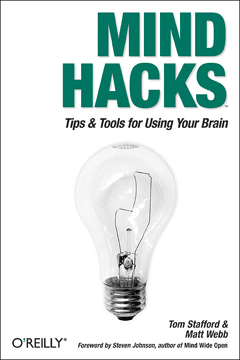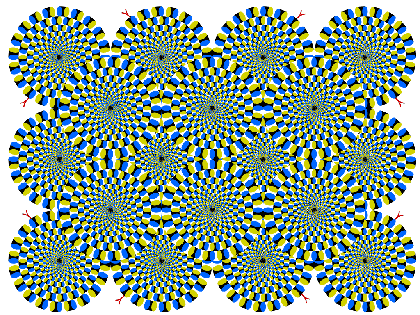Review: Mind Hacks (book)

Price: $25
Trial: 8 of the 100 hacks are available on the book’s Web site.
Emo Philips used to tell a joke that went something like this: “I used to think that the brain was the most wonderful organ in my body. Then I realized who was telling me this.” For some reason my mind thought of that as it read a book about ways to trick itself, particularly when it encountered one of those many tricks which worked even if it knew the trick in advance.
Other volumes in O’Reilly’s Hacks series will give you tips for hacking OS X or Google; Mind Hacks is about the human brain. Applying the term Hacks to any of these “Hacks” is a bit tenuous; you’re not modifying or reprogramming your brain with new abilities, just getting a better understanding of it. A better analogy would be using a program in all sorts of ways and discovering strange bugs, cases in which the program acts unexpectedly…and then thinking about just what there might be in the program to cause it to behave that way.

The Hacks
The hundred hacks in the book are grouped into categories (e.g. Seeing, Moving, Remembering) and can (really) be read or skipped in any order, though I do suggest reading the first chapter first for a little background information. There’s a lot of cross-referencing in the hacks, referring the reader both forwards and backwards in the book for related information.
Each hack begins with an introductory summary, then moves to an “In Action” section that describes the experience/phenomenon in question and a “How It Works” section that explains or at least theorizes about what’s going on inside the brain. Occasionally insight from a previous hack allowed me to come up with my own ideas of why something worked: sometimes my thoughts would be confirmed, other times I was left wondering if I might be on to something.
Each hack is only a few pages long, including both text and pictures; you’re only getting the tip of the iceberg of the complicated subjects that are covered. “End Notes” and “See Also” sections following each hack direct the reader to sources of research and academic studies. I like that many of these references are online (read: free); the book offers lots of jumping-off points for research projects and experiments.
I found most of the hacks in the book to be interesting, and though I’d encountered a number of them before (optical illusions are easily found online, for example, and the placebo effect is well-known) there was easily enough material to keep me interested (creating false memories, subitizing, sight influencing perception of sound…). Even if I’d already discovered a particular piece of anomalous brain functioning in my own real-life experiences, the book encouraged me to think about why my brain works the way it does.
Trying It
As implied by the “In Action” section, most of the hacks are written with the intent that you “try it yourself,” so you can experience the discussed strange brain functioning first-hand (or try to; there were some cases in which I did not experience the described effect). It’s actually pretty impressive how much we can learn about the brain without making use of fMRIs and EEGs and other such high-end equipment. Sometimes I’d read a hack I’d never heard of before and think, Yeah that’ll work…and then I’d try it and it would work…but how did I know?
It’s understandable that most books in the Hacks series require you to be in front of a computer in order to get the most out of them. But I take my brain everywhere; I shouldn’t need to be sitting in front of my Mac as I read Mind Hacks, right? Wrong. Most of the hacks direct you to some Web site or other to watch a movie or a Flash animation or to see a series of pictures; the book is well-illustrated, but only in black-and-white and often, that’s not enough. A few stills from a movie might give the reader a vague idea of what’s supposed to happen, but certainly doesn’t let the reader experience the effect being described.

Image by Akiyoshi Kitaoka
Nearly all of the URLs the book offers are long and unwieldy; I wish the book’s authors had used a service like tinyURL to shorten them. Or they could have made the book more reader-friendly by posting a page of links on the O’Reilly Web site; someone sitting at his computer reading the book could then click on a link rather than be required to type it out.
Conclusion
This is a book that pits the conscious mind against the unconscious mind. I am programmed, but I am also aware of it and I have the ability to investigate my own inner workings. My brain perceives something wrongly, but after reading Mind Hacks I know that it’s perceiving wrongly and why and how. But if I know then my brain knows…and yet the illusion continues to work. Mind Hacks offers an interesting introduction to some of the peculiar propensities of the human mind.
Reader Comments (1)
As you're reading Mind Hacks, keep that page open on your browser and you'll save a lot of typing.
Add A Comment